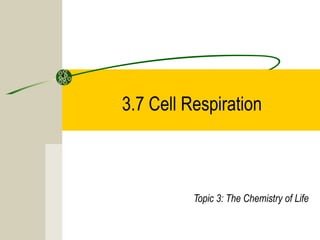
3 130909221817-
- 1. 3.7 Cell Respiration Topic 3: The Chemistry of Life
- 2. Cellular Respiration 3.7.1 Define cell respiration - the controlled release of energy from organic compounds in cells to form ATP. 3.7.2 State that, in cell respiration, glucose in the cytoplasm is broken down by glycolysis into pyruvate, with a small yield of ATP.
- 3. Cellular Respiration 3.7.3 Explain that, during anaerobic cell respiration, pyruvate can be converted in the cytoplasm into lactate, or ethanol and carbon dioxide, with no further yield of ATP. Mention that ethanol and carbon dioxide are produced in yeast, whereas lactate is produced in humans. 3.7.4 Explain that, during aerobic cell respiration, pyruvate can be broken down in the mitochondrion into carbon dioxide and water with a large yield of ATP.
- 4. Cellular Respiration Most people use the term respiration in reference to breathing. Biologists use the term in a different way. To biologists, respiration is: “The controlled release of energy in the form of ATP from organic compounds in cells” To avoid confusion, this process is sometimes called cellular respiration. Cellular respiration occurs in every living cell. It is the only way a cell can obtain energy in a usable form.
- 5. ATP ATP stands for adenosine triphosphate. ATP is the form of chemical energy that is used to fuel energy consuming biological reactions. All living things need energy to grow, reproduce, move, repair, etc. They obtain this energy from food. Food can be made in the organism (photosynthesis) or taken in by eating (heterotrophs). During cellular respiration the energy in food molecules is transferred to molecules of ATP.
- 6. Types of Cellular Respiration There are TWO main types of Cellular Respiration: – Anaerobic Respiration. • Respiration without oxygen – Aerobic Respiration. • Respiration with oxygen
- 7. Glycolysis Glucose is often the organic compound used in cell respiration. Glycolysis is the first stage of both anaerobic and aerobic respiration. It takes place in the cytoplasm of the cell. Glucose molecules are broken down into pyruvate molecules with the release of a small amount of energy (2 ATP). Actually 4 ATP are produced, but 2 are used in the process giving a net yield of 2 ATP Glucose 2 pyruvate + 2 ATP
- 8. Anaerobic Respiration When oxygen is not available, anaerobic respiration may occur. In the absence of oxygen, glucose can only be partly broken down, the molecules produced will be larger and there will be less energy available to the cell. The name given to these anaerobic processes is Fermentation.
- 9. Anaerobic Respiration There are generally two types of fermentation: – Alcohol fermentation: • Which occurs in plants and yeasts. – Lactate fermentation: • Which occurs in animals. In both of these reactions, no further yield of ATP is produced. pyruvate pyruvate ethanol + carbon dioxide lactate (lactic acid)
- 10. Alcohol Fermentation In a number of organisms, (particularly some plants, yeast and bacteria) glucose can be broken down to ethanol and carbon dioxide. The reaction can be summarised as: This reaction is the basis of the brewing and baking industries. The net production of energy is 2 ATP (from the glycolysis stage). C6H12O6 2C2H5OH + 2CO2 + energy glucose carbon dioxide energy++ethanol
- 11. Lactate Fermentation In animals, respiration may also occur in the absence of oxygen. This is much less efficient and the lactate (lactic acid) that is produced is poisonous to the cells. The reaction can be summarised as: Lactate can build up in muscles after exercise and cause soreness. The net production of energy is 2 ATP (from the glycolysis stage). C6H12O6 + energy2C3H6O3 glucose energy+lactate
- 12. Aerobic Respiration Aerobic respiration occurs when oxygen is present. The pyruvate from glycolysis moves to the Mitochondria. Inside the mitochondria the pyruvate is broken down into carbon dioxide and water. A large amount of ATP is produced (about 36 ATP). pyruvate carbon dioxide + water + energy
- 13. Aerobic Respiration Aerobic respiration can be summarised as: C6H12O6 + 6O2 6CO2 + 6H20 + energy glucose + oxygen carbon dioxide + water + energy
- 14. Comparing Aerobic and Fermentation The first stage of fermentation is the same as for aerobic respiration – glycolysis, which produces 2 pyruvate molecules. However, in fermentation the pyruvate is converted to ethanol and CO2 (plants and yeast) or lactate (animals). This final process occurs in the cytoplasm (as compared to in the mitochondria in aerobic respiration). Fermentation does not produce as much ATP as aerobic respiration because the products are bigger. Aerobic respiration is 17 times more effective than fermentation at producing ATP molecules.
- 15. Comparing Aerobic and Fermentation Aerobic respiration Anaerobic respiration Site in eukaryote cytoplasm/mitochondria cytoplasm Reactants glucose and oxygen glucose Products CO2 and H2O ethanol and CO2 or lactate ATPs per glucose 36 2
- 16. IBO guide: 3.7.1 Define cell respiration - the controlled release of energyfrom organic compounds in cells to form ATP. 3.7.2 State that, in cell respiration, glucose in the cytoplasm is broken down by glycolysis into pyruvate, with a small yield of ATP.
- 17. IBO guide: 3.7.3 Explain that, during anaerobic cell respiration, pyruvate can be converted in the cytoplasm into lactate, or ethanol and carbon dioxide, with no further yield of ATP. Mention that ethanol and carbon dioxide are produced in yeast, whereas lactate is produced in humans. 3.7.4 Explain that, during aerobic cell respiration, pyruvate can be broken down in the mitochondrion into carbon dioxide and water with a large yield of ATP.
